Analysis of Health Concepts, Policy, and the Columbian Exchange
VerifiedAdded on 2023/01/23
|19
|5391
|92
Essay
AI Summary
This essay provides a comprehensive analysis of key concepts in health sciences, including the distinctions between health studies and health sciences, health, healthcare, and medical care. It examines Canadian healthcare through the lens of different insurance typologies and delves into the significance of the biomedical perspective in health studies. Furthermore, the essay evaluates the impact of the Columbian Exchange on humanity and critiques the limited public policy action addressing health outcomes based on the determinants of health. It also analyzes recommendations from the Standing Senate Committee on Social Affairs, Science and Technology, focusing on obesity in Canada and employing the 3-I framework to assess their implementation.
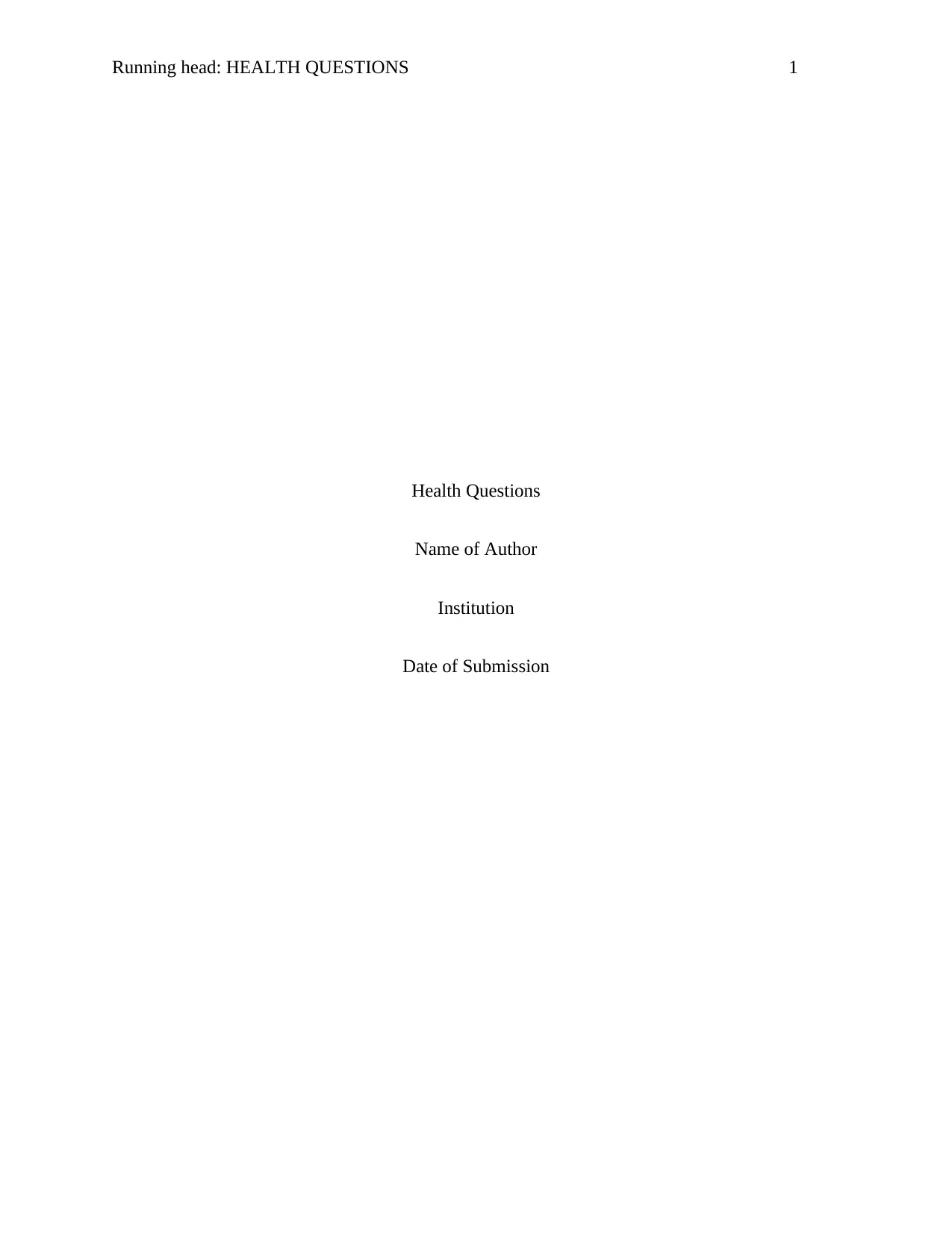
Running head: HEALTH QUESTIONS 1
Health Questions
Name of Author
Institution
Date of Submission
Health Questions
Name of Author
Institution
Date of Submission
Paraphrase This Document
Need a fresh take? Get an instant paraphrase of this document with our AI Paraphraser
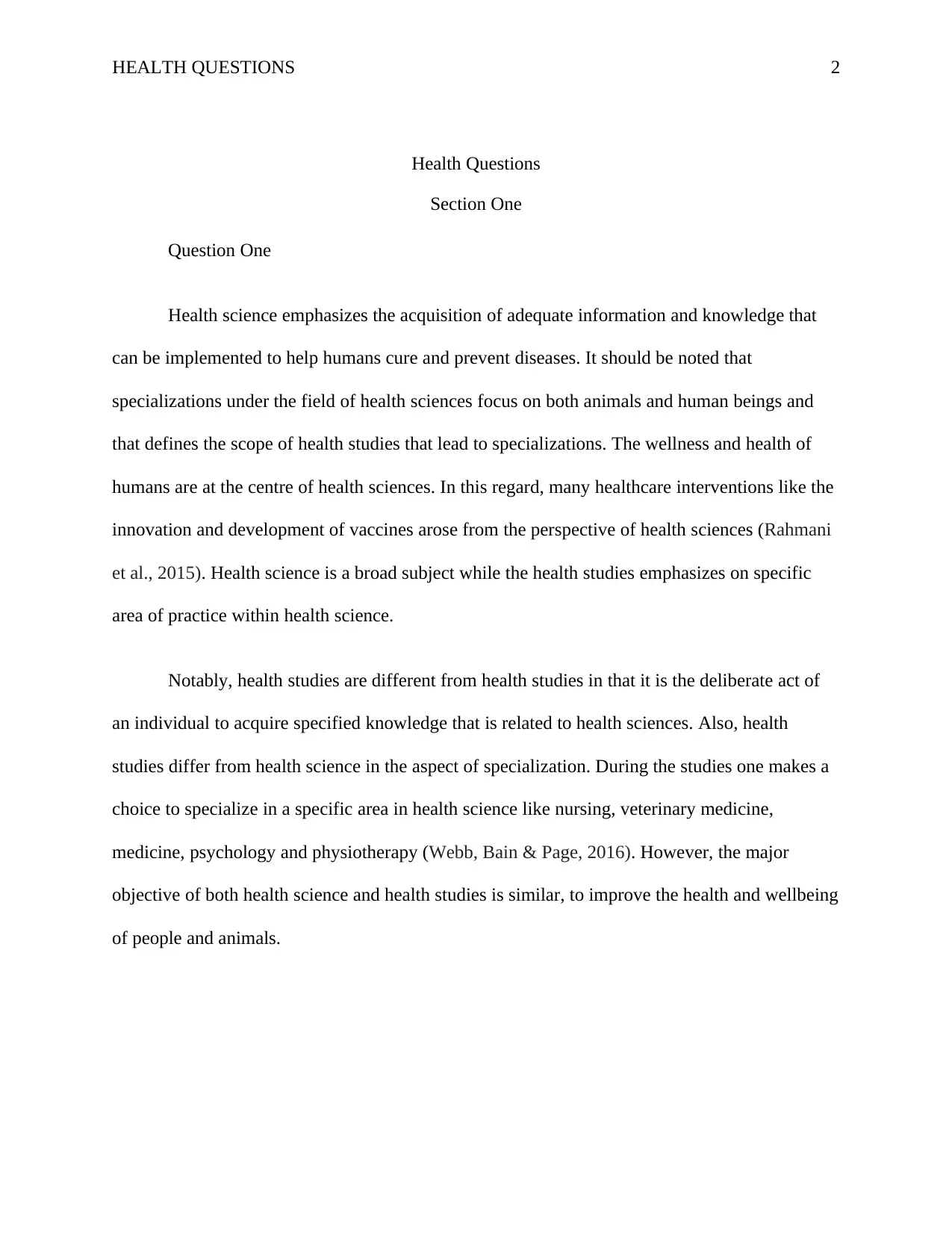
HEALTH QUESTIONS 2
Health Questions
Section One
Question One
Health science emphasizes the acquisition of adequate information and knowledge that
can be implemented to help humans cure and prevent diseases. It should be noted that
specializations under the field of health sciences focus on both animals and human beings and
that defines the scope of health studies that lead to specializations. The wellness and health of
humans are at the centre of health sciences. In this regard, many healthcare interventions like the
innovation and development of vaccines arose from the perspective of health sciences (Rahmani
et al., 2015). Health science is a broad subject while the health studies emphasizes on specific
area of practice within health science.
Notably, health studies are different from health studies in that it is the deliberate act of
an individual to acquire specified knowledge that is related to health sciences. Also, health
studies differ from health science in the aspect of specialization. During the studies one makes a
choice to specialize in a specific area in health science like nursing, veterinary medicine,
medicine, psychology and physiotherapy (Webb, Bain & Page, 2016). However, the major
objective of both health science and health studies is similar, to improve the health and wellbeing
of people and animals.
Health Questions
Section One
Question One
Health science emphasizes the acquisition of adequate information and knowledge that
can be implemented to help humans cure and prevent diseases. It should be noted that
specializations under the field of health sciences focus on both animals and human beings and
that defines the scope of health studies that lead to specializations. The wellness and health of
humans are at the centre of health sciences. In this regard, many healthcare interventions like the
innovation and development of vaccines arose from the perspective of health sciences (Rahmani
et al., 2015). Health science is a broad subject while the health studies emphasizes on specific
area of practice within health science.
Notably, health studies are different from health studies in that it is the deliberate act of
an individual to acquire specified knowledge that is related to health sciences. Also, health
studies differ from health science in the aspect of specialization. During the studies one makes a
choice to specialize in a specific area in health science like nursing, veterinary medicine,
medicine, psychology and physiotherapy (Webb, Bain & Page, 2016). However, the major
objective of both health science and health studies is similar, to improve the health and wellbeing
of people and animals.
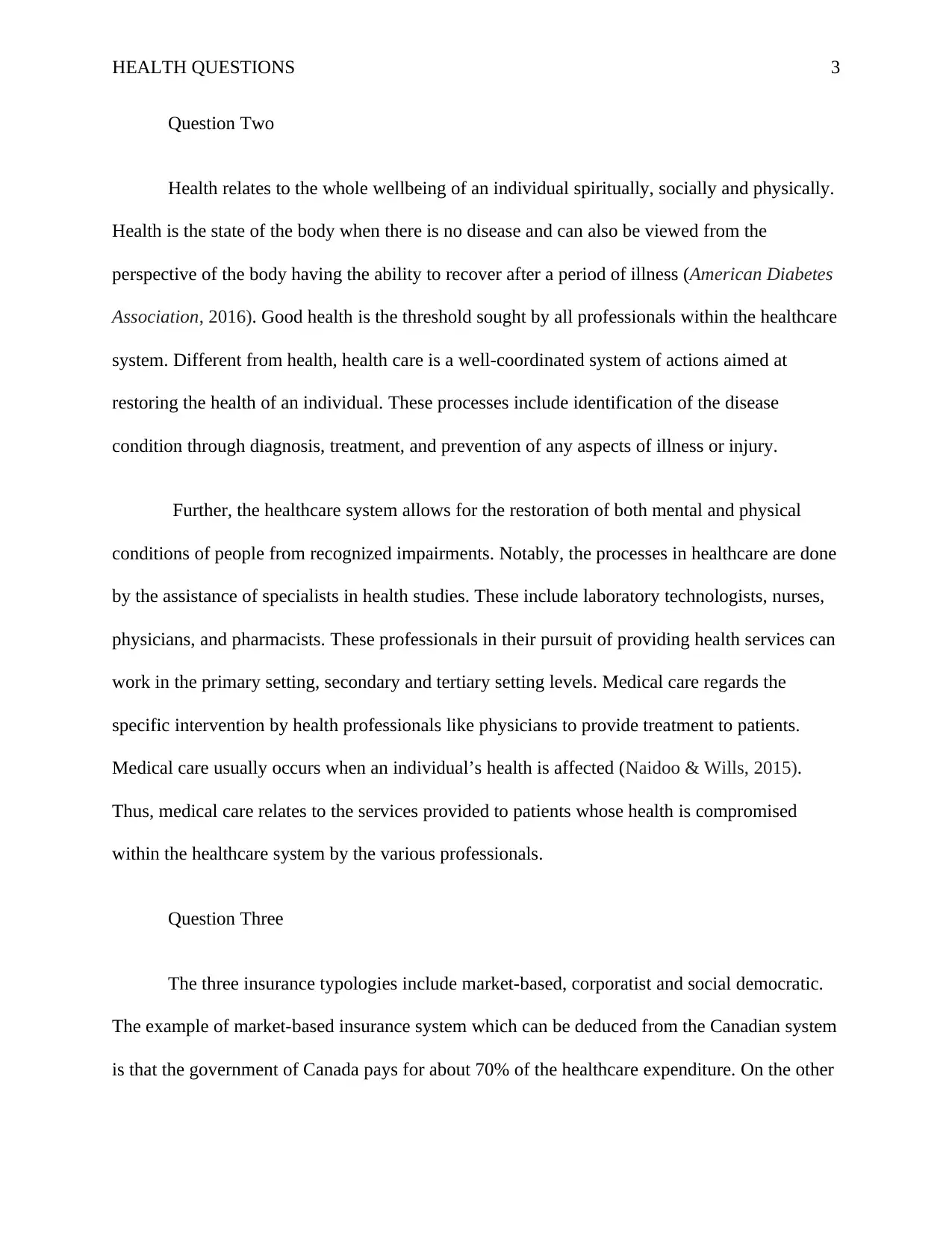
HEALTH QUESTIONS 3
Question Two
Health relates to the whole wellbeing of an individual spiritually, socially and physically.
Health is the state of the body when there is no disease and can also be viewed from the
perspective of the body having the ability to recover after a period of illness (American Diabetes
Association, 2016). Good health is the threshold sought by all professionals within the healthcare
system. Different from health, health care is a well-coordinated system of actions aimed at
restoring the health of an individual. These processes include identification of the disease
condition through diagnosis, treatment, and prevention of any aspects of illness or injury.
Further, the healthcare system allows for the restoration of both mental and physical
conditions of people from recognized impairments. Notably, the processes in healthcare are done
by the assistance of specialists in health studies. These include laboratory technologists, nurses,
physicians, and pharmacists. These professionals in their pursuit of providing health services can
work in the primary setting, secondary and tertiary setting levels. Medical care regards the
specific intervention by health professionals like physicians to provide treatment to patients.
Medical care usually occurs when an individual’s health is affected (Naidoo & Wills, 2015).
Thus, medical care relates to the services provided to patients whose health is compromised
within the healthcare system by the various professionals.
Question Three
The three insurance typologies include market-based, corporatist and social democratic.
The example of market-based insurance system which can be deduced from the Canadian system
is that the government of Canada pays for about 70% of the healthcare expenditure. On the other
Question Two
Health relates to the whole wellbeing of an individual spiritually, socially and physically.
Health is the state of the body when there is no disease and can also be viewed from the
perspective of the body having the ability to recover after a period of illness (American Diabetes
Association, 2016). Good health is the threshold sought by all professionals within the healthcare
system. Different from health, health care is a well-coordinated system of actions aimed at
restoring the health of an individual. These processes include identification of the disease
condition through diagnosis, treatment, and prevention of any aspects of illness or injury.
Further, the healthcare system allows for the restoration of both mental and physical
conditions of people from recognized impairments. Notably, the processes in healthcare are done
by the assistance of specialists in health studies. These include laboratory technologists, nurses,
physicians, and pharmacists. These professionals in their pursuit of providing health services can
work in the primary setting, secondary and tertiary setting levels. Medical care regards the
specific intervention by health professionals like physicians to provide treatment to patients.
Medical care usually occurs when an individual’s health is affected (Naidoo & Wills, 2015).
Thus, medical care relates to the services provided to patients whose health is compromised
within the healthcare system by the various professionals.
Question Three
The three insurance typologies include market-based, corporatist and social democratic.
The example of market-based insurance system which can be deduced from the Canadian system
is that the government of Canada pays for about 70% of the healthcare expenditure. On the other
⊘ This is a preview!⊘
Do you want full access?
Subscribe today to unlock all pages.

Trusted by 1+ million students worldwide
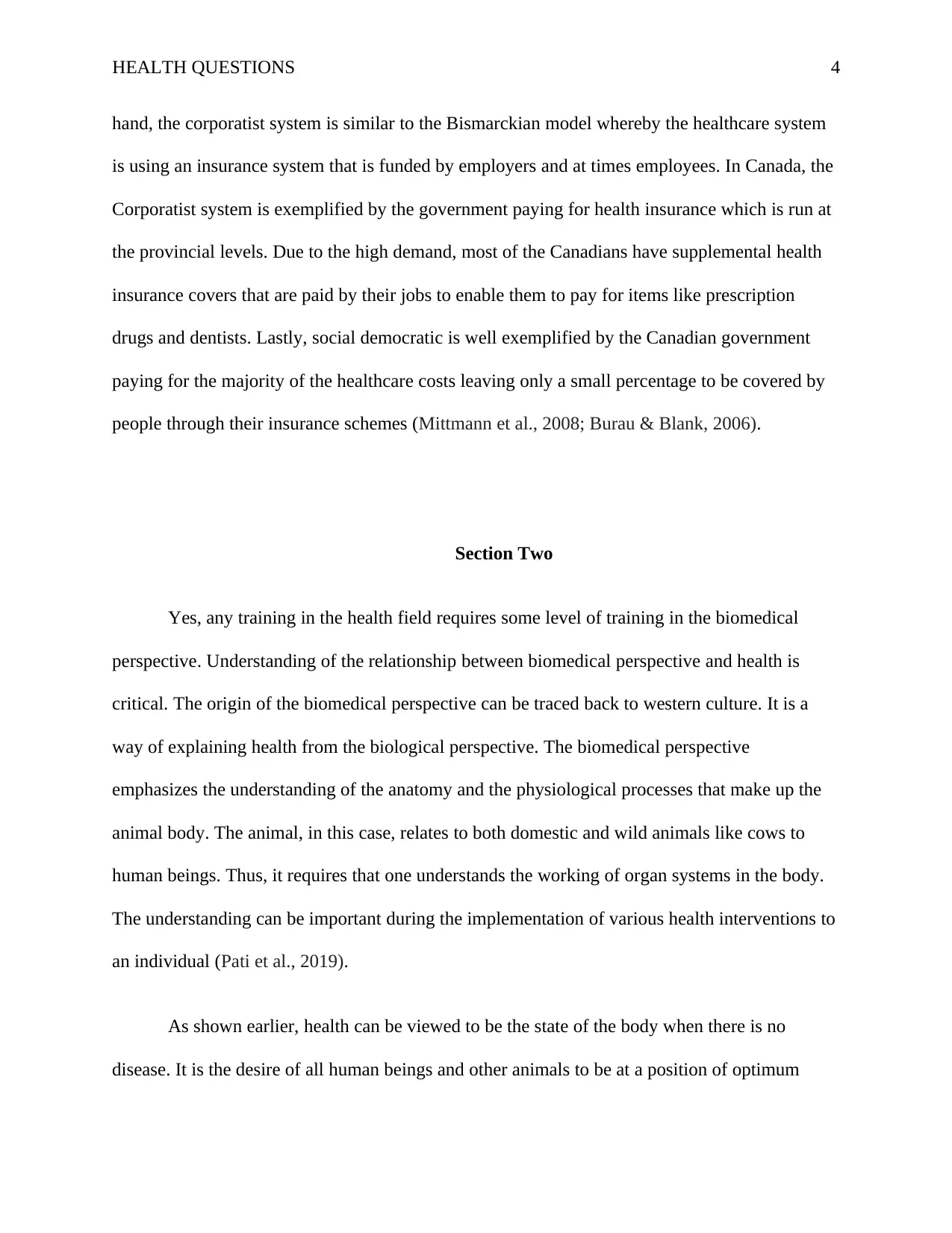
HEALTH QUESTIONS 4
hand, the corporatist system is similar to the Bismarckian model whereby the healthcare system
is using an insurance system that is funded by employers and at times employees. In Canada, the
Corporatist system is exemplified by the government paying for health insurance which is run at
the provincial levels. Due to the high demand, most of the Canadians have supplemental health
insurance covers that are paid by their jobs to enable them to pay for items like prescription
drugs and dentists. Lastly, social democratic is well exemplified by the Canadian government
paying for the majority of the healthcare costs leaving only a small percentage to be covered by
people through their insurance schemes (Mittmann et al., 2008; Burau & Blank, 2006).
Section Two
Yes, any training in the health field requires some level of training in the biomedical
perspective. Understanding of the relationship between biomedical perspective and health is
critical. The origin of the biomedical perspective can be traced back to western culture. It is a
way of explaining health from the biological perspective. The biomedical perspective
emphasizes the understanding of the anatomy and the physiological processes that make up the
animal body. The animal, in this case, relates to both domestic and wild animals like cows to
human beings. Thus, it requires that one understands the working of organ systems in the body.
The understanding can be important during the implementation of various health interventions to
an individual (Pati et al., 2019).
As shown earlier, health can be viewed to be the state of the body when there is no
disease. It is the desire of all human beings and other animals to be at a position of optimum
hand, the corporatist system is similar to the Bismarckian model whereby the healthcare system
is using an insurance system that is funded by employers and at times employees. In Canada, the
Corporatist system is exemplified by the government paying for health insurance which is run at
the provincial levels. Due to the high demand, most of the Canadians have supplemental health
insurance covers that are paid by their jobs to enable them to pay for items like prescription
drugs and dentists. Lastly, social democratic is well exemplified by the Canadian government
paying for the majority of the healthcare costs leaving only a small percentage to be covered by
people through their insurance schemes (Mittmann et al., 2008; Burau & Blank, 2006).
Section Two
Yes, any training in the health field requires some level of training in the biomedical
perspective. Understanding of the relationship between biomedical perspective and health is
critical. The origin of the biomedical perspective can be traced back to western culture. It is a
way of explaining health from the biological perspective. The biomedical perspective
emphasizes the understanding of the anatomy and the physiological processes that make up the
animal body. The animal, in this case, relates to both domestic and wild animals like cows to
human beings. Thus, it requires that one understands the working of organ systems in the body.
The understanding can be important during the implementation of various health interventions to
an individual (Pati et al., 2019).
As shown earlier, health can be viewed to be the state of the body when there is no
disease. It is the desire of all human beings and other animals to be at a position of optimum
Paraphrase This Document
Need a fresh take? Get an instant paraphrase of this document with our AI Paraphraser
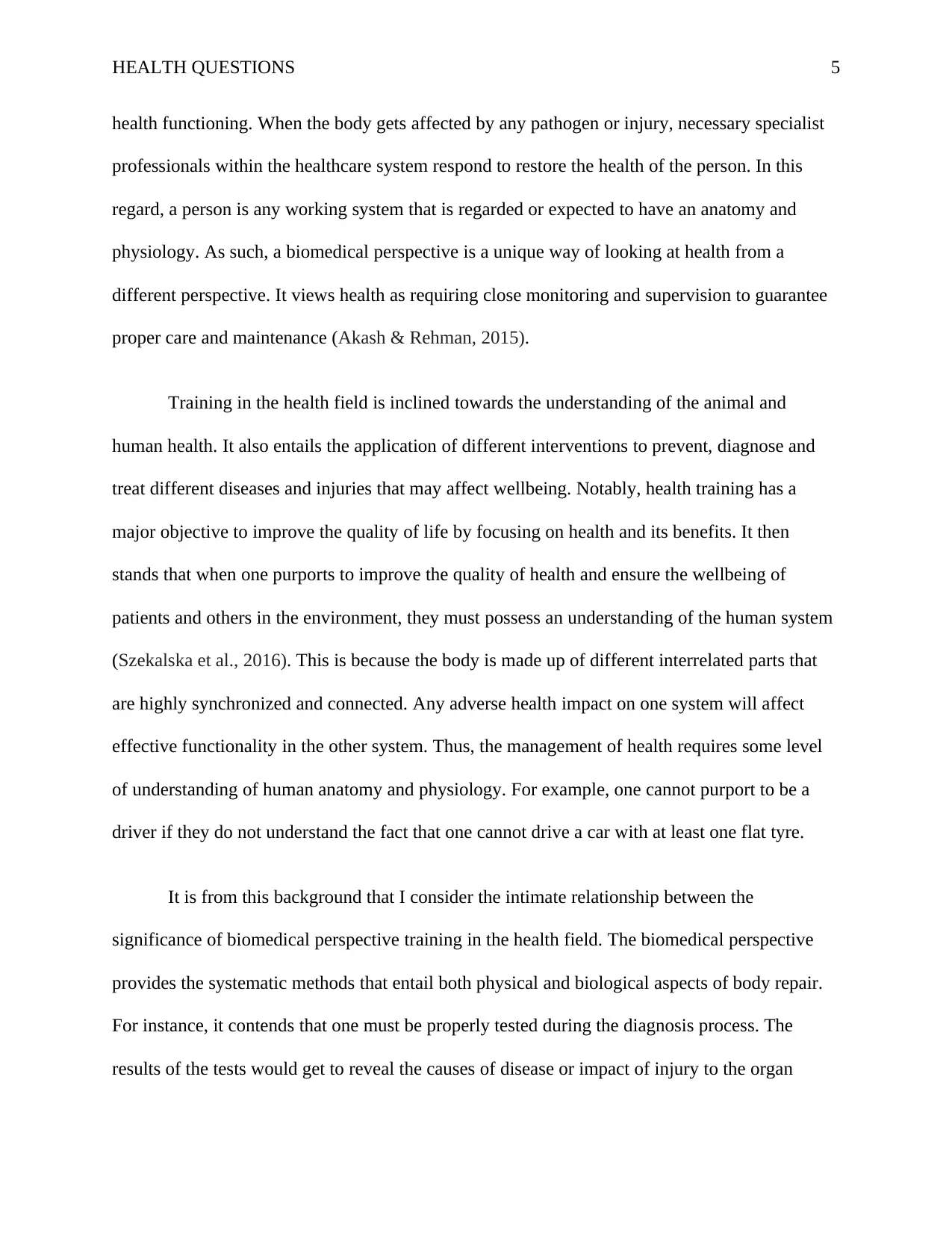
HEALTH QUESTIONS 5
health functioning. When the body gets affected by any pathogen or injury, necessary specialist
professionals within the healthcare system respond to restore the health of the person. In this
regard, a person is any working system that is regarded or expected to have an anatomy and
physiology. As such, a biomedical perspective is a unique way of looking at health from a
different perspective. It views health as requiring close monitoring and supervision to guarantee
proper care and maintenance (Akash & Rehman, 2015).
Training in the health field is inclined towards the understanding of the animal and
human health. It also entails the application of different interventions to prevent, diagnose and
treat different diseases and injuries that may affect wellbeing. Notably, health training has a
major objective to improve the quality of life by focusing on health and its benefits. It then
stands that when one purports to improve the quality of health and ensure the wellbeing of
patients and others in the environment, they must possess an understanding of the human system
(Szekalska et al., 2016). This is because the body is made up of different interrelated parts that
are highly synchronized and connected. Any adverse health impact on one system will affect
effective functionality in the other system. Thus, the management of health requires some level
of understanding of human anatomy and physiology. For example, one cannot purport to be a
driver if they do not understand the fact that one cannot drive a car with at least one flat tyre.
It is from this background that I consider the intimate relationship between the
significance of biomedical perspective training in the health field. The biomedical perspective
provides the systematic methods that entail both physical and biological aspects of body repair.
For instance, it contends that one must be properly tested during the diagnosis process. The
results of the tests would get to reveal the causes of disease or impact of injury to the organ
health functioning. When the body gets affected by any pathogen or injury, necessary specialist
professionals within the healthcare system respond to restore the health of the person. In this
regard, a person is any working system that is regarded or expected to have an anatomy and
physiology. As such, a biomedical perspective is a unique way of looking at health from a
different perspective. It views health as requiring close monitoring and supervision to guarantee
proper care and maintenance (Akash & Rehman, 2015).
Training in the health field is inclined towards the understanding of the animal and
human health. It also entails the application of different interventions to prevent, diagnose and
treat different diseases and injuries that may affect wellbeing. Notably, health training has a
major objective to improve the quality of life by focusing on health and its benefits. It then
stands that when one purports to improve the quality of health and ensure the wellbeing of
patients and others in the environment, they must possess an understanding of the human system
(Szekalska et al., 2016). This is because the body is made up of different interrelated parts that
are highly synchronized and connected. Any adverse health impact on one system will affect
effective functionality in the other system. Thus, the management of health requires some level
of understanding of human anatomy and physiology. For example, one cannot purport to be a
driver if they do not understand the fact that one cannot drive a car with at least one flat tyre.
It is from this background that I consider the intimate relationship between the
significance of biomedical perspective training in the health field. The biomedical perspective
provides the systematic methods that entail both physical and biological aspects of body repair.
For instance, it contends that one must be properly tested during the diagnosis process. The
results of the tests would get to reveal the causes of disease or impact of injury to the organ
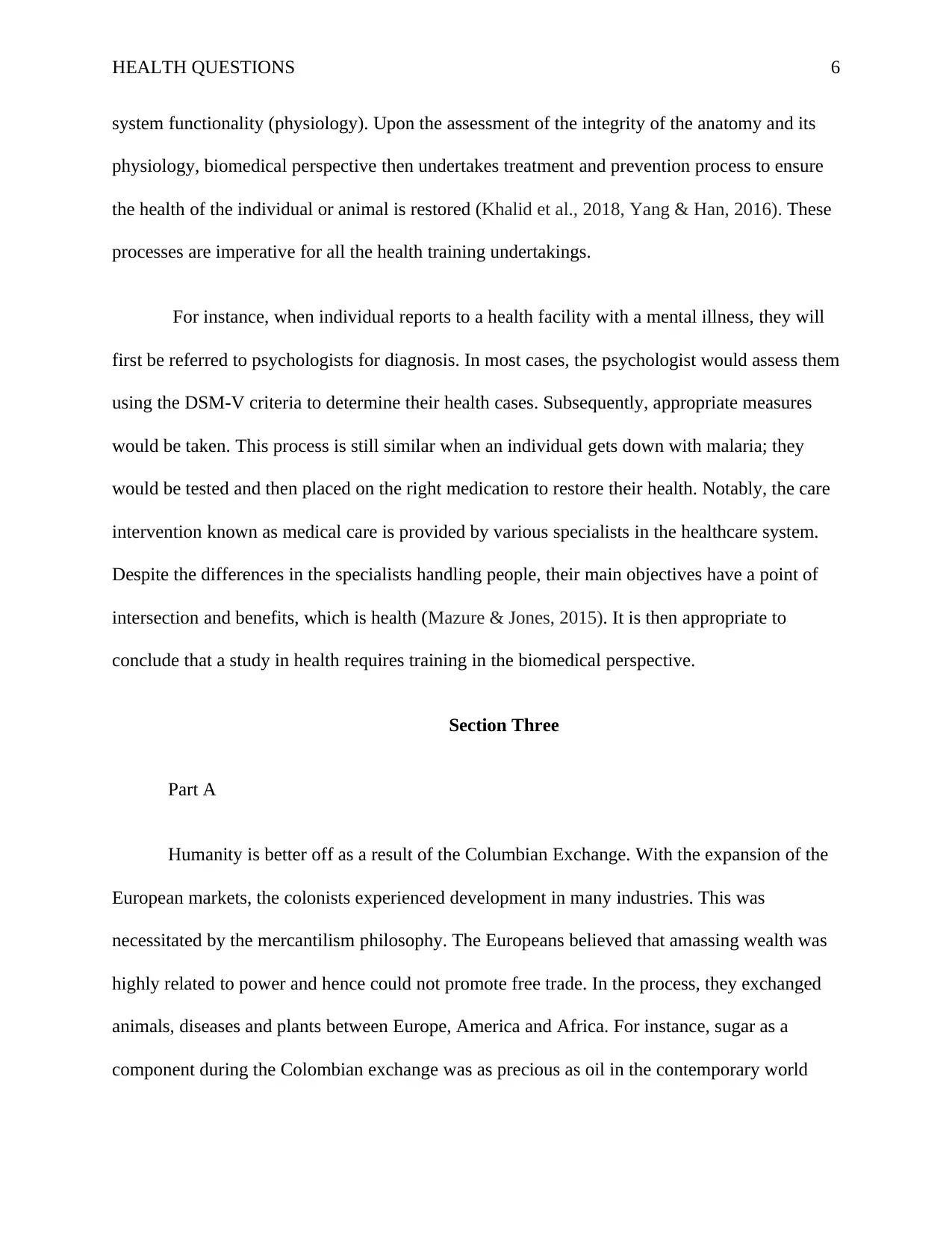
HEALTH QUESTIONS 6
system functionality (physiology). Upon the assessment of the integrity of the anatomy and its
physiology, biomedical perspective then undertakes treatment and prevention process to ensure
the health of the individual or animal is restored (Khalid et al., 2018, Yang & Han, 2016). These
processes are imperative for all the health training undertakings.
For instance, when individual reports to a health facility with a mental illness, they will
first be referred to psychologists for diagnosis. In most cases, the psychologist would assess them
using the DSM-V criteria to determine their health cases. Subsequently, appropriate measures
would be taken. This process is still similar when an individual gets down with malaria; they
would be tested and then placed on the right medication to restore their health. Notably, the care
intervention known as medical care is provided by various specialists in the healthcare system.
Despite the differences in the specialists handling people, their main objectives have a point of
intersection and benefits, which is health (Mazure & Jones, 2015). It is then appropriate to
conclude that a study in health requires training in the biomedical perspective.
Section Three
Part A
Humanity is better off as a result of the Columbian Exchange. With the expansion of the
European markets, the colonists experienced development in many industries. This was
necessitated by the mercantilism philosophy. The Europeans believed that amassing wealth was
highly related to power and hence could not promote free trade. In the process, they exchanged
animals, diseases and plants between Europe, America and Africa. For instance, sugar as a
component during the Colombian exchange was as precious as oil in the contemporary world
system functionality (physiology). Upon the assessment of the integrity of the anatomy and its
physiology, biomedical perspective then undertakes treatment and prevention process to ensure
the health of the individual or animal is restored (Khalid et al., 2018, Yang & Han, 2016). These
processes are imperative for all the health training undertakings.
For instance, when individual reports to a health facility with a mental illness, they will
first be referred to psychologists for diagnosis. In most cases, the psychologist would assess them
using the DSM-V criteria to determine their health cases. Subsequently, appropriate measures
would be taken. This process is still similar when an individual gets down with malaria; they
would be tested and then placed on the right medication to restore their health. Notably, the care
intervention known as medical care is provided by various specialists in the healthcare system.
Despite the differences in the specialists handling people, their main objectives have a point of
intersection and benefits, which is health (Mazure & Jones, 2015). It is then appropriate to
conclude that a study in health requires training in the biomedical perspective.
Section Three
Part A
Humanity is better off as a result of the Columbian Exchange. With the expansion of the
European markets, the colonists experienced development in many industries. This was
necessitated by the mercantilism philosophy. The Europeans believed that amassing wealth was
highly related to power and hence could not promote free trade. In the process, they exchanged
animals, diseases and plants between Europe, America and Africa. For instance, sugar as a
component during the Colombian exchange was as precious as oil in the contemporary world
⊘ This is a preview!⊘
Do you want full access?
Subscribe today to unlock all pages.

Trusted by 1+ million students worldwide
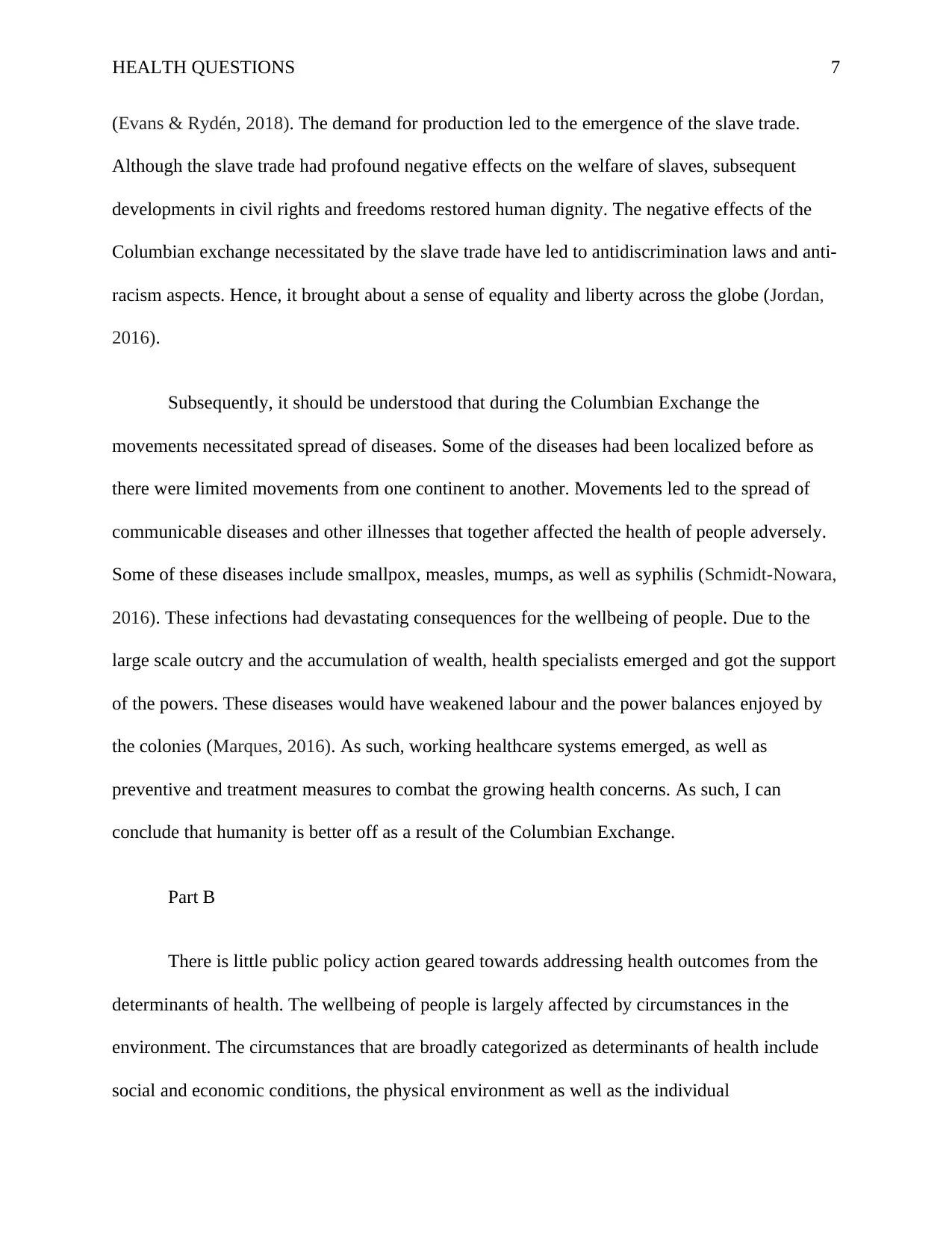
HEALTH QUESTIONS 7
(Evans & Rydén, 2018). The demand for production led to the emergence of the slave trade.
Although the slave trade had profound negative effects on the welfare of slaves, subsequent
developments in civil rights and freedoms restored human dignity. The negative effects of the
Columbian exchange necessitated by the slave trade have led to antidiscrimination laws and anti-
racism aspects. Hence, it brought about a sense of equality and liberty across the globe (Jordan,
2016).
Subsequently, it should be understood that during the Columbian Exchange the
movements necessitated spread of diseases. Some of the diseases had been localized before as
there were limited movements from one continent to another. Movements led to the spread of
communicable diseases and other illnesses that together affected the health of people adversely.
Some of these diseases include smallpox, measles, mumps, as well as syphilis (Schmidt-Nowara,
2016). These infections had devastating consequences for the wellbeing of people. Due to the
large scale outcry and the accumulation of wealth, health specialists emerged and got the support
of the powers. These diseases would have weakened labour and the power balances enjoyed by
the colonies (Marques, 2016). As such, working healthcare systems emerged, as well as
preventive and treatment measures to combat the growing health concerns. As such, I can
conclude that humanity is better off as a result of the Columbian Exchange.
Part B
There is little public policy action geared towards addressing health outcomes from the
determinants of health. The wellbeing of people is largely affected by circumstances in the
environment. The circumstances that are broadly categorized as determinants of health include
social and economic conditions, the physical environment as well as the individual
(Evans & Rydén, 2018). The demand for production led to the emergence of the slave trade.
Although the slave trade had profound negative effects on the welfare of slaves, subsequent
developments in civil rights and freedoms restored human dignity. The negative effects of the
Columbian exchange necessitated by the slave trade have led to antidiscrimination laws and anti-
racism aspects. Hence, it brought about a sense of equality and liberty across the globe (Jordan,
2016).
Subsequently, it should be understood that during the Columbian Exchange the
movements necessitated spread of diseases. Some of the diseases had been localized before as
there were limited movements from one continent to another. Movements led to the spread of
communicable diseases and other illnesses that together affected the health of people adversely.
Some of these diseases include smallpox, measles, mumps, as well as syphilis (Schmidt-Nowara,
2016). These infections had devastating consequences for the wellbeing of people. Due to the
large scale outcry and the accumulation of wealth, health specialists emerged and got the support
of the powers. These diseases would have weakened labour and the power balances enjoyed by
the colonies (Marques, 2016). As such, working healthcare systems emerged, as well as
preventive and treatment measures to combat the growing health concerns. As such, I can
conclude that humanity is better off as a result of the Columbian Exchange.
Part B
There is little public policy action geared towards addressing health outcomes from the
determinants of health. The wellbeing of people is largely affected by circumstances in the
environment. The circumstances that are broadly categorized as determinants of health include
social and economic conditions, the physical environment as well as the individual
Paraphrase This Document
Need a fresh take? Get an instant paraphrase of this document with our AI Paraphraser
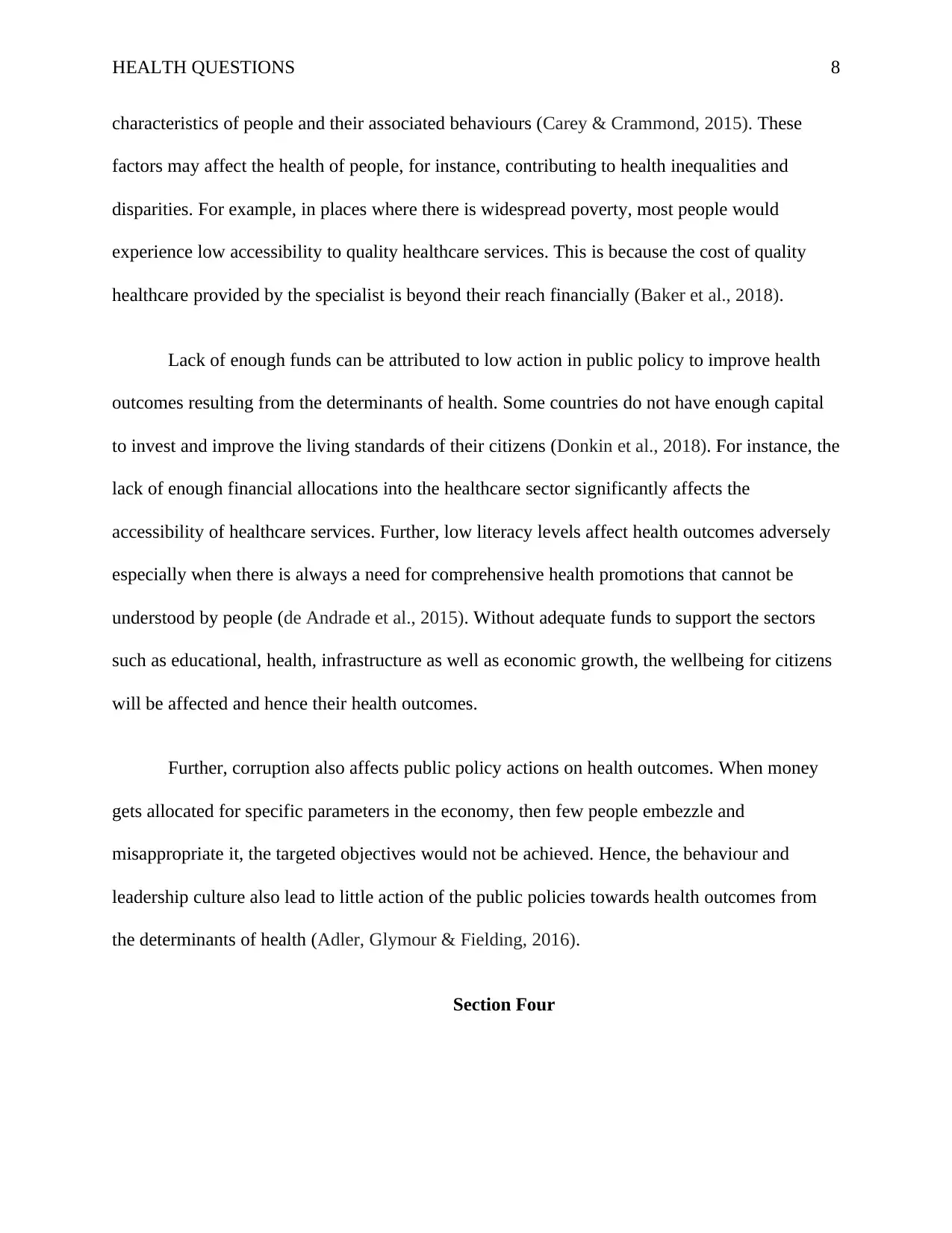
HEALTH QUESTIONS 8
characteristics of people and their associated behaviours (Carey & Crammond, 2015). These
factors may affect the health of people, for instance, contributing to health inequalities and
disparities. For example, in places where there is widespread poverty, most people would
experience low accessibility to quality healthcare services. This is because the cost of quality
healthcare provided by the specialist is beyond their reach financially (Baker et al., 2018).
Lack of enough funds can be attributed to low action in public policy to improve health
outcomes resulting from the determinants of health. Some countries do not have enough capital
to invest and improve the living standards of their citizens (Donkin et al., 2018). For instance, the
lack of enough financial allocations into the healthcare sector significantly affects the
accessibility of healthcare services. Further, low literacy levels affect health outcomes adversely
especially when there is always a need for comprehensive health promotions that cannot be
understood by people (de Andrade et al., 2015). Without adequate funds to support the sectors
such as educational, health, infrastructure as well as economic growth, the wellbeing for citizens
will be affected and hence their health outcomes.
Further, corruption also affects public policy actions on health outcomes. When money
gets allocated for specific parameters in the economy, then few people embezzle and
misappropriate it, the targeted objectives would not be achieved. Hence, the behaviour and
leadership culture also lead to little action of the public policies towards health outcomes from
the determinants of health (Adler, Glymour & Fielding, 2016).
Section Four
characteristics of people and their associated behaviours (Carey & Crammond, 2015). These
factors may affect the health of people, for instance, contributing to health inequalities and
disparities. For example, in places where there is widespread poverty, most people would
experience low accessibility to quality healthcare services. This is because the cost of quality
healthcare provided by the specialist is beyond their reach financially (Baker et al., 2018).
Lack of enough funds can be attributed to low action in public policy to improve health
outcomes resulting from the determinants of health. Some countries do not have enough capital
to invest and improve the living standards of their citizens (Donkin et al., 2018). For instance, the
lack of enough financial allocations into the healthcare sector significantly affects the
accessibility of healthcare services. Further, low literacy levels affect health outcomes adversely
especially when there is always a need for comprehensive health promotions that cannot be
understood by people (de Andrade et al., 2015). Without adequate funds to support the sectors
such as educational, health, infrastructure as well as economic growth, the wellbeing for citizens
will be affected and hence their health outcomes.
Further, corruption also affects public policy actions on health outcomes. When money
gets allocated for specific parameters in the economy, then few people embezzle and
misappropriate it, the targeted objectives would not be achieved. Hence, the behaviour and
leadership culture also lead to little action of the public policies towards health outcomes from
the determinants of health (Adler, Glymour & Fielding, 2016).
Section Four
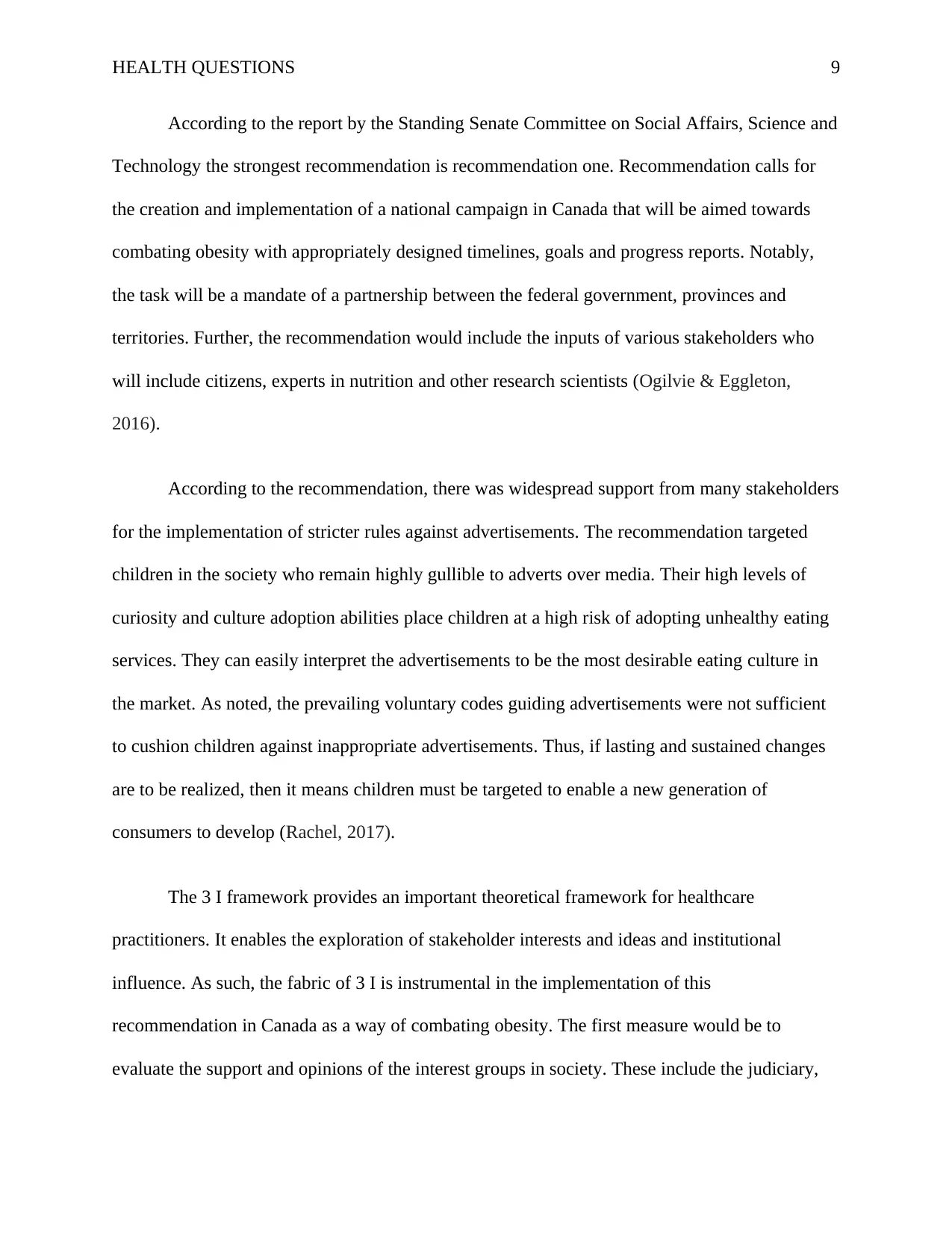
HEALTH QUESTIONS 9
According to the report by the Standing Senate Committee on Social Affairs, Science and
Technology the strongest recommendation is recommendation one. Recommendation calls for
the creation and implementation of a national campaign in Canada that will be aimed towards
combating obesity with appropriately designed timelines, goals and progress reports. Notably,
the task will be a mandate of a partnership between the federal government, provinces and
territories. Further, the recommendation would include the inputs of various stakeholders who
will include citizens, experts in nutrition and other research scientists (Ogilvie & Eggleton,
2016).
According to the recommendation, there was widespread support from many stakeholders
for the implementation of stricter rules against advertisements. The recommendation targeted
children in the society who remain highly gullible to adverts over media. Their high levels of
curiosity and culture adoption abilities place children at a high risk of adopting unhealthy eating
services. They can easily interpret the advertisements to be the most desirable eating culture in
the market. As noted, the prevailing voluntary codes guiding advertisements were not sufficient
to cushion children against inappropriate advertisements. Thus, if lasting and sustained changes
are to be realized, then it means children must be targeted to enable a new generation of
consumers to develop (Rachel, 2017).
The 3 I framework provides an important theoretical framework for healthcare
practitioners. It enables the exploration of stakeholder interests and ideas and institutional
influence. As such, the fabric of 3 I is instrumental in the implementation of this
recommendation in Canada as a way of combating obesity. The first measure would be to
evaluate the support and opinions of the interest groups in society. These include the judiciary,
According to the report by the Standing Senate Committee on Social Affairs, Science and
Technology the strongest recommendation is recommendation one. Recommendation calls for
the creation and implementation of a national campaign in Canada that will be aimed towards
combating obesity with appropriately designed timelines, goals and progress reports. Notably,
the task will be a mandate of a partnership between the federal government, provinces and
territories. Further, the recommendation would include the inputs of various stakeholders who
will include citizens, experts in nutrition and other research scientists (Ogilvie & Eggleton,
2016).
According to the recommendation, there was widespread support from many stakeholders
for the implementation of stricter rules against advertisements. The recommendation targeted
children in the society who remain highly gullible to adverts over media. Their high levels of
curiosity and culture adoption abilities place children at a high risk of adopting unhealthy eating
services. They can easily interpret the advertisements to be the most desirable eating culture in
the market. As noted, the prevailing voluntary codes guiding advertisements were not sufficient
to cushion children against inappropriate advertisements. Thus, if lasting and sustained changes
are to be realized, then it means children must be targeted to enable a new generation of
consumers to develop (Rachel, 2017).
The 3 I framework provides an important theoretical framework for healthcare
practitioners. It enables the exploration of stakeholder interests and ideas and institutional
influence. As such, the fabric of 3 I is instrumental in the implementation of this
recommendation in Canada as a way of combating obesity. The first measure would be to
evaluate the support and opinions of the interest groups in society. These include the judiciary,
⊘ This is a preview!⊘
Do you want full access?
Subscribe today to unlock all pages.

Trusted by 1+ million students worldwide
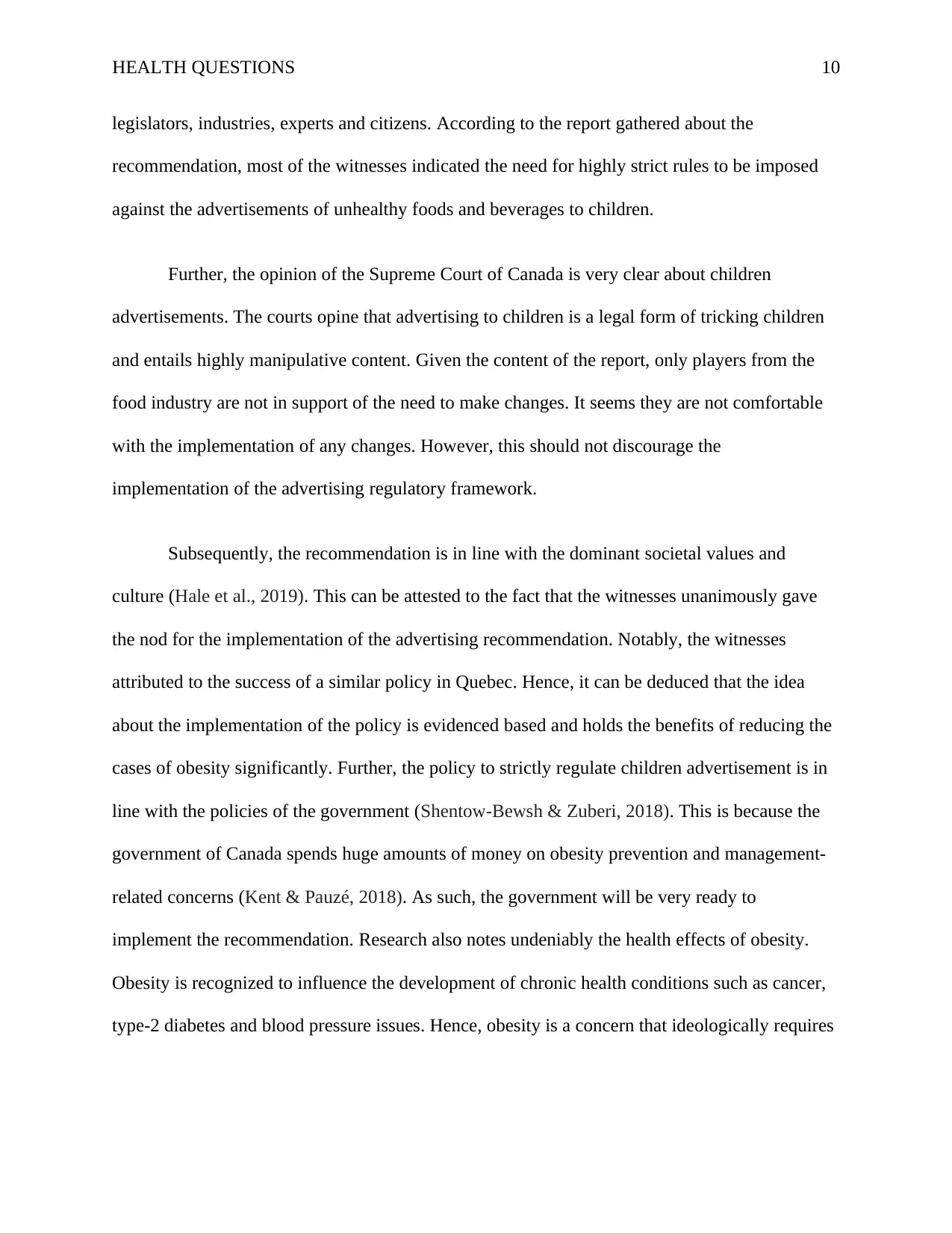
HEALTH QUESTIONS 10
legislators, industries, experts and citizens. According to the report gathered about the
recommendation, most of the witnesses indicated the need for highly strict rules to be imposed
against the advertisements of unhealthy foods and beverages to children.
Further, the opinion of the Supreme Court of Canada is very clear about children
advertisements. The courts opine that advertising to children is a legal form of tricking children
and entails highly manipulative content. Given the content of the report, only players from the
food industry are not in support of the need to make changes. It seems they are not comfortable
with the implementation of any changes. However, this should not discourage the
implementation of the advertising regulatory framework.
Subsequently, the recommendation is in line with the dominant societal values and
culture (Hale et al., 2019). This can be attested to the fact that the witnesses unanimously gave
the nod for the implementation of the advertising recommendation. Notably, the witnesses
attributed to the success of a similar policy in Quebec. Hence, it can be deduced that the idea
about the implementation of the policy is evidenced based and holds the benefits of reducing the
cases of obesity significantly. Further, the policy to strictly regulate children advertisement is in
line with the policies of the government (Shentow-Bewsh & Zuberi, 2018). This is because the
government of Canada spends huge amounts of money on obesity prevention and management-
related concerns (Kent & Pauzé, 2018). As such, the government will be very ready to
implement the recommendation. Research also notes undeniably the health effects of obesity.
Obesity is recognized to influence the development of chronic health conditions such as cancer,
type-2 diabetes and blood pressure issues. Hence, obesity is a concern that ideologically requires
legislators, industries, experts and citizens. According to the report gathered about the
recommendation, most of the witnesses indicated the need for highly strict rules to be imposed
against the advertisements of unhealthy foods and beverages to children.
Further, the opinion of the Supreme Court of Canada is very clear about children
advertisements. The courts opine that advertising to children is a legal form of tricking children
and entails highly manipulative content. Given the content of the report, only players from the
food industry are not in support of the need to make changes. It seems they are not comfortable
with the implementation of any changes. However, this should not discourage the
implementation of the advertising regulatory framework.
Subsequently, the recommendation is in line with the dominant societal values and
culture (Hale et al., 2019). This can be attested to the fact that the witnesses unanimously gave
the nod for the implementation of the advertising recommendation. Notably, the witnesses
attributed to the success of a similar policy in Quebec. Hence, it can be deduced that the idea
about the implementation of the policy is evidenced based and holds the benefits of reducing the
cases of obesity significantly. Further, the policy to strictly regulate children advertisement is in
line with the policies of the government (Shentow-Bewsh & Zuberi, 2018). This is because the
government of Canada spends huge amounts of money on obesity prevention and management-
related concerns (Kent & Pauzé, 2018). As such, the government will be very ready to
implement the recommendation. Research also notes undeniably the health effects of obesity.
Obesity is recognized to influence the development of chronic health conditions such as cancer,
type-2 diabetes and blood pressure issues. Hence, obesity is a concern that ideologically requires
Paraphrase This Document
Need a fresh take? Get an instant paraphrase of this document with our AI Paraphraser
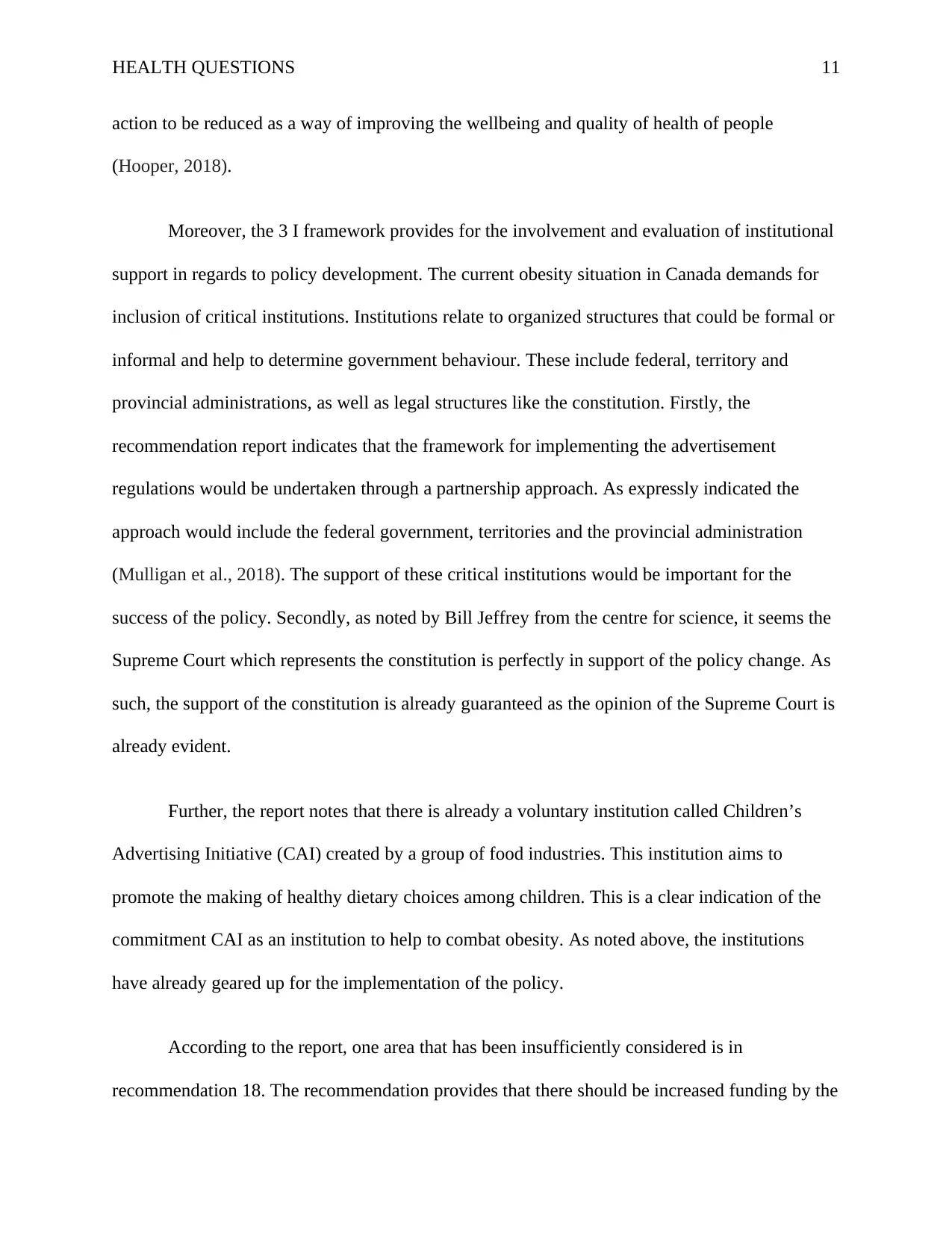
HEALTH QUESTIONS 11
action to be reduced as a way of improving the wellbeing and quality of health of people
(Hooper, 2018).
Moreover, the 3 I framework provides for the involvement and evaluation of institutional
support in regards to policy development. The current obesity situation in Canada demands for
inclusion of critical institutions. Institutions relate to organized structures that could be formal or
informal and help to determine government behaviour. These include federal, territory and
provincial administrations, as well as legal structures like the constitution. Firstly, the
recommendation report indicates that the framework for implementing the advertisement
regulations would be undertaken through a partnership approach. As expressly indicated the
approach would include the federal government, territories and the provincial administration
(Mulligan et al., 2018). The support of these critical institutions would be important for the
success of the policy. Secondly, as noted by Bill Jeffrey from the centre for science, it seems the
Supreme Court which represents the constitution is perfectly in support of the policy change. As
such, the support of the constitution is already guaranteed as the opinion of the Supreme Court is
already evident.
Further, the report notes that there is already a voluntary institution called Children’s
Advertising Initiative (CAI) created by a group of food industries. This institution aims to
promote the making of healthy dietary choices among children. This is a clear indication of the
commitment CAI as an institution to help to combat obesity. As noted above, the institutions
have already geared up for the implementation of the policy.
According to the report, one area that has been insufficiently considered is in
recommendation 18. The recommendation provides that there should be increased funding by the
action to be reduced as a way of improving the wellbeing and quality of health of people
(Hooper, 2018).
Moreover, the 3 I framework provides for the involvement and evaluation of institutional
support in regards to policy development. The current obesity situation in Canada demands for
inclusion of critical institutions. Institutions relate to organized structures that could be formal or
informal and help to determine government behaviour. These include federal, territory and
provincial administrations, as well as legal structures like the constitution. Firstly, the
recommendation report indicates that the framework for implementing the advertisement
regulations would be undertaken through a partnership approach. As expressly indicated the
approach would include the federal government, territories and the provincial administration
(Mulligan et al., 2018). The support of these critical institutions would be important for the
success of the policy. Secondly, as noted by Bill Jeffrey from the centre for science, it seems the
Supreme Court which represents the constitution is perfectly in support of the policy change. As
such, the support of the constitution is already guaranteed as the opinion of the Supreme Court is
already evident.
Further, the report notes that there is already a voluntary institution called Children’s
Advertising Initiative (CAI) created by a group of food industries. This institution aims to
promote the making of healthy dietary choices among children. This is a clear indication of the
commitment CAI as an institution to help to combat obesity. As noted above, the institutions
have already geared up for the implementation of the policy.
According to the report, one area that has been insufficiently considered is in
recommendation 18. The recommendation provides that there should be increased funding by the
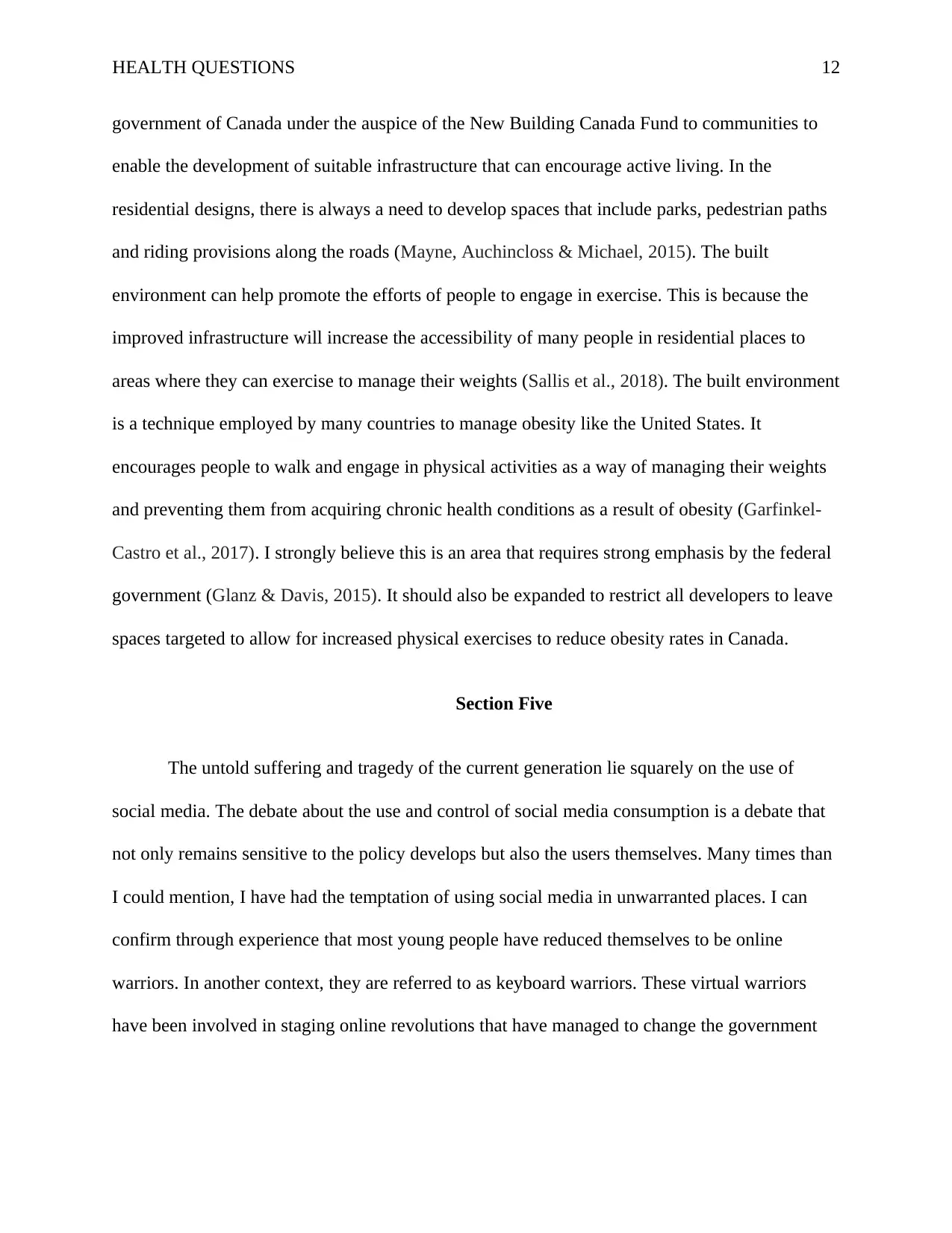
HEALTH QUESTIONS 12
government of Canada under the auspice of the New Building Canada Fund to communities to
enable the development of suitable infrastructure that can encourage active living. In the
residential designs, there is always a need to develop spaces that include parks, pedestrian paths
and riding provisions along the roads (Mayne, Auchincloss & Michael, 2015). The built
environment can help promote the efforts of people to engage in exercise. This is because the
improved infrastructure will increase the accessibility of many people in residential places to
areas where they can exercise to manage their weights (Sallis et al., 2018). The built environment
is a technique employed by many countries to manage obesity like the United States. It
encourages people to walk and engage in physical activities as a way of managing their weights
and preventing them from acquiring chronic health conditions as a result of obesity (Garfinkel-
Castro et al., 2017). I strongly believe this is an area that requires strong emphasis by the federal
government (Glanz & Davis, 2015). It should also be expanded to restrict all developers to leave
spaces targeted to allow for increased physical exercises to reduce obesity rates in Canada.
Section Five
The untold suffering and tragedy of the current generation lie squarely on the use of
social media. The debate about the use and control of social media consumption is a debate that
not only remains sensitive to the policy develops but also the users themselves. Many times than
I could mention, I have had the temptation of using social media in unwarranted places. I can
confirm through experience that most young people have reduced themselves to be online
warriors. In another context, they are referred to as keyboard warriors. These virtual warriors
have been involved in staging online revolutions that have managed to change the government
government of Canada under the auspice of the New Building Canada Fund to communities to
enable the development of suitable infrastructure that can encourage active living. In the
residential designs, there is always a need to develop spaces that include parks, pedestrian paths
and riding provisions along the roads (Mayne, Auchincloss & Michael, 2015). The built
environment can help promote the efforts of people to engage in exercise. This is because the
improved infrastructure will increase the accessibility of many people in residential places to
areas where they can exercise to manage their weights (Sallis et al., 2018). The built environment
is a technique employed by many countries to manage obesity like the United States. It
encourages people to walk and engage in physical activities as a way of managing their weights
and preventing them from acquiring chronic health conditions as a result of obesity (Garfinkel-
Castro et al., 2017). I strongly believe this is an area that requires strong emphasis by the federal
government (Glanz & Davis, 2015). It should also be expanded to restrict all developers to leave
spaces targeted to allow for increased physical exercises to reduce obesity rates in Canada.
Section Five
The untold suffering and tragedy of the current generation lie squarely on the use of
social media. The debate about the use and control of social media consumption is a debate that
not only remains sensitive to the policy develops but also the users themselves. Many times than
I could mention, I have had the temptation of using social media in unwarranted places. I can
confirm through experience that most young people have reduced themselves to be online
warriors. In another context, they are referred to as keyboard warriors. These virtual warriors
have been involved in staging online revolutions that have managed to change the government
⊘ This is a preview!⊘
Do you want full access?
Subscribe today to unlock all pages.

Trusted by 1+ million students worldwide
1 out of 19
Related Documents
Your All-in-One AI-Powered Toolkit for Academic Success.
+13062052269
info@desklib.com
Available 24*7 on WhatsApp / Email
![[object Object]](/_next/static/media/star-bottom.7253800d.svg)
Unlock your academic potential
Copyright © 2020–2025 A2Z Services. All Rights Reserved. Developed and managed by ZUCOL.





